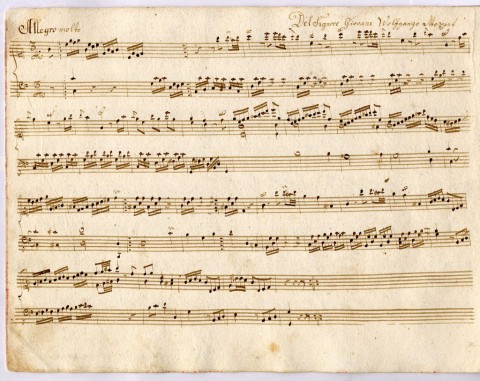A music scholar made an astounding discovery recently while going through the personal belongings from the attic of a recently deceased church musician and band leader in the Lech Valley of the Austrian Tyrol.
Combing through the dead man’s collection of old music manuscripts, Hildegard Herrmann-Schneider of the Institute for Tyrolean Music Research noticed a hand-written book with the date “1780” on the cover. On pages 12 to 14 she found an unidentified sonata movement with the tempo mark “allegro molto,” Italian for “very quickly.” On the upper right-hand side of page 12 was written “Del Signore Giovane Wolfgango Mozart,” or “The young Wolfgango Mozart.”
“Wolfgango” was a name Mozart’s father, Leopold, called him when he was a boy. Looking further into the manuscript, Herrmann-Schneider found several pieces that were already known to have been written by Leopold Mozart. Those compositions were respectfully marked “Signore Mozart,” or “Lord Mozart.”
Although the writing was clearly not in the hand of either the elder or the younger Mozart, the meticulousness of the transcriptions, along with the accuracy of every verifiable detail throughout the 160-page book, led Herrmann-Schneider to suspect that the composition by “The Young Wolfgango Mozart” was an authentic, previously unknown piece.
On the back of the manuscript was the copyist’s name: Johannes Reiserer. After an extensive investigation, Herrmann-Schneider was able to learn that Reiserer was born in 1765 and had gone to gymnasium, or high school, in Salzburg, where he was a member of the cathedral choir from 1778 to 1780. That would have placed him in close proximity to Leopold Mozart. “Researchers have thus concluded,” writes The History Blog, “that Johannes Reiserer used the notebook to copy compositions as part of a rigorous program of music instruction by Kapellhaus music masters, perhaps Leopold himself.”
Based on the style and the level of accomplishment in the piece, now known as the “Allegro Molto in C Major,” researchers place the date of composition at around 1767, when Mozart was 11 years old. A press release from the Institute for Tyrolean Music Research describes the piece:
Mozart frequently selected a C‑major key, and the Allegro molto has a sonata form with a length of 84 measures. Its ambitus is tailored to the clavichord. The Allegro molto could be a first major attempt by Wolfgang Amadé to assert himself in the area of the sonata form. This is suggested by the relatively high level of compositional technique.…Throughout the Allegro molto, thematic formation, compositional setting and harmony have a number of components that are found repeated in other Mozart piano works. Hardly a compositional detail points to a contradiction with the general characteristics of Mozart’s comsummate musical composition. According to current scholarly knowledge, it must therefore be regarded as an authentic sonata movement by Wolfgang Amadeus Mozart.
Austrian musician Florian Birsak, who specializes in playing early keyboard instruments, gave the premier performance of the piece on Mozart’s own fortepiano last Friday at the Mozart family home in Salzburg, which is now a museum of the Salzburg Mozarteum Foundation. You can watch a video, above, which was recorded sometime earlier in the same place and on the same instrument. You can also read a PDF of the score, and download Birsak’s recording at iTunes.
The first page of Mozart’s Allegro Molto in C Major (above) from the 1780 notebook. Credit: Salzburg Mozarteum Foundation.
via @MatthiasRascher



It is incredible that this piece has been sitting around unnoticed for so long. Makes you hope there may be more somewhere.
I don’t normally volunteer my addy for a comment, but this is beautiful. A little speedy, and the recital isn’t exactly flawless in execution but skilled all the same. Not one single composer these days could write anything that brilliant. Bravisimo, Mozart.
Astonishing how fresh and yet unmistakably Mozart it sounds. I wish we could find some of his sister’s work as well.
Beautiful.… And playful, like a young boy.
This is great! So wonderful that after all this time he can still astonish us. I hope that even more pices will be discovered.
The video is private now! Can;t find it anywhere. Unfair is what it is!
This is truly remarkable by any standard and sense. Is it possible to obtain a pdf-copy of the score?
Yes, very truly indeed a work by a genius, no doubt it’s no one else but Mozart who wrote it! And I completely agree myself that this piece had to most likely be a second movement of a sonata if it were written for a sonata! But that’s only a question of it were left unfinished or not found yet? And I actually believe that this was instead just a single movement Molto Allegro in C, it doesn’t necessarily have to be a sonata to be recognized as a keyboard work! In fact, it could’ve been a preparation work for Wolfgango to start to get him ready to write music in the sonata form!